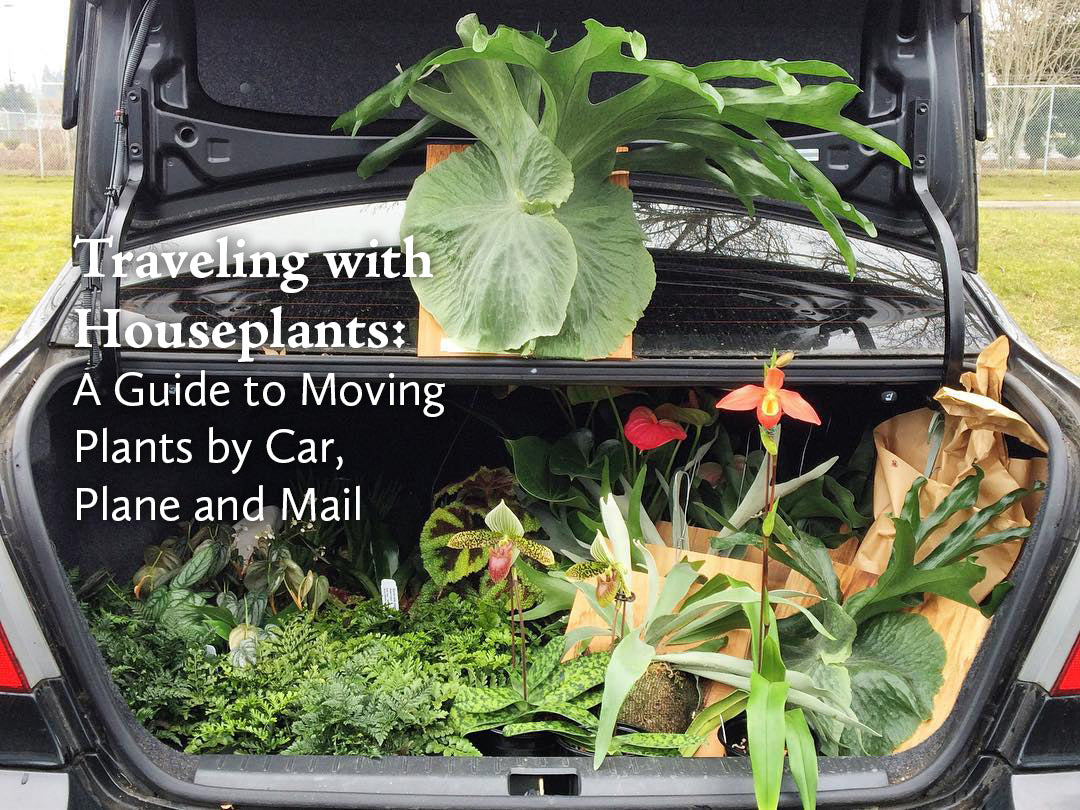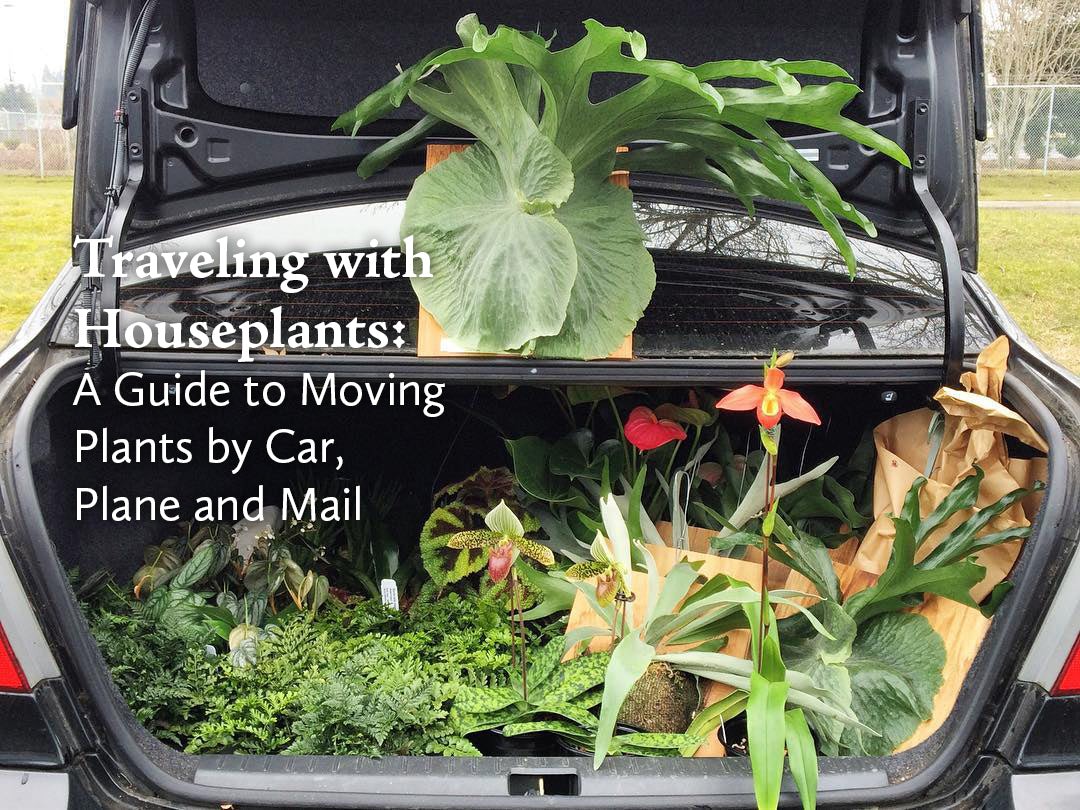Can I Travel With Plants? Absolutely! TRAVELS.EDU.VN understands that for plant enthusiasts, bringing your leafy companions along is essential, whether you’re moving, gifting, or simply expanding your collection. This comprehensive guide offers expert advice and tips for safely transporting your plants, ensuring they arrive at their destination healthy and thriving, focusing on the legalities, best practices, and temperature considerations that can affect your plant travel plans. We’ll explore everything from preparing your plants to shipping them securely, providing you with all the necessary knowledge.
1. Preparing Your Plants for Travel
Preparing your houseplants for travel is crucial for their well-being. Think of it as giving them a spa day before a big trip. A week or two before your journey, take these steps to ensure they’re in top condition:
1.1. Preening and Pruning
Remove any dead, damaged, or yellowing leaves. Trimming back long or meandering vines can make handling easier. This reduces the risk of damage during transit and minimizes the plant’s need for resources it can’t easily access while traveling.
1.2. Repotting Considerations
Consider repotting plants into plastic nursery pots to reduce weight and the risk of breakage. If you decide to repot, do it well in advance of your travel date to give the plant time to adjust.
1.3. Pest and Disease Control
Inspect your plants thoroughly for any signs of pests or diseases. Treat any infestations with appropriate insecticides or fungicides well before traveling to prevent further spread. A clean bill of health is essential for a smooth journey.
1.4. Cleaning Foliage
Gently dust the foliage with a damp cloth or soft brush. Clean leaves can photosynthesize more efficiently, which is especially beneficial during travel when light conditions may be less than ideal.
1.5. Watering Wisely
Water thirsty plants like ferns the day before or early in the morning of travel, especially in hot weather. For other plants, water a few days before to ensure the soil is lightly moist but not waterlogged. Overwatering can lead to root rot, especially in dark, cool conditions.
 Preparing houseplants for travel includes pruning and pest control
Preparing houseplants for travel includes pruning and pest control
2. Traveling with Houseplants in the Car
Traveling with houseplants in your car requires careful planning to ensure their safety and comfort. It’s similar to traveling with pets – you need to consider temperature, light, and stability.
2.1. Temperature Control
Maintain a comfortable temperature inside your car. Avoid leaving plants in a hot car, as this can quickly lead to overheating and damage. On cold days, ensure the car is warm enough to prevent chilling injuries.
2.2. Protection from Dirt and Moisture
Use a shower curtain or tarp to protect your car’s interior from dirt and moisture. This is especially useful if you’re transporting multiple plants or those in larger pots.
2.3. Packing Plants Securely
Pack plants in sturdy boxes to prevent them from tipping over. Arrange the boxes on the floor or seats, ensuring they are stable. Use newspaper or packing material to fill empty spaces and provide additional support.
2.4. Air Circulation
If you cover the boxes, make sure to cut air holes for ventilation. Plants need fresh air to prevent the buildup of humidity, which can encourage fungal growth.
2.5. Hydration and Humidity
On hot days, pack pots with lightly dampened newspaper or sphagnum moss to keep plants cool and humid. This helps to counteract the dry air inside the car.
2.6. Securing Large Plants
Buckle in larger plants or place their pots in garbage bags to avoid spillage. Leave the bag slightly open at the top to allow the soil to breathe.
2.7. Using Carriers
Consider using a birdcage, dog crate, or cat carrier for delicate or prized specimens. Cover these structures with a sheer cloth to protect plants from harsh light.
2.8. Light Exposure
Expose plants to light daily, but avoid direct sunlight on a hot backseat. Rest stops are a great opportunity to find a spot with bright, indirect light.
2.9. Overnight Stays
Bring plants inside with you during overnight stays, especially in cold weather. One night in a freezing car can severely damage or kill a tropical plant.
2.10. Watering on the Road
Water plants sparingly in hotel sinks or bathtubs if they dry out. If a long trip requires keeping plants covered during the day, leave them in a hotel tub with the bathroom light or a grow light overnight.
 A ficus lyrata packed for car travel, emphasizing the importance of safe packing
A ficus lyrata packed for car travel, emphasizing the importance of safe packing
3. State and International Regulations
Before moving your plant collection across state lines or internationally, it’s crucial to check specific regulations. Some states, like California, Arizona, and Florida, have stricter rules.
3.1. Researching Regulations
Always research the current rules and regulations regarding plant material declarations. The U.S. Customs & Border Protection website is a valuable resource. For international travel, contact your destination country’s department of agriculture to find out about potential fees and permits.
3.2. Traveling to Canada
If you’re traveling into Canada, be aware of restrictions on bringing plants. Brush up on current rules and regulations to avoid any legal issues.
 Ferns secured with seatbelts, illustrating plant safety during travel
Ferns secured with seatbelts, illustrating plant safety during travel
4. Traveling with Houseplants on Planes
Traveling with houseplants on planes can be more complex, but it is possible with proper preparation and adherence to airline policies.
4.1. Airline Policies
Each airline has its own policies regarding houseplants, but generally, they are welcome in carry-on or checked bags if they comply with baggage rules.
4.2. Inspection Preparation
Be prepared to unpack plants for inspection and send them through the x-ray machine. This may require some disassembly, so pack accordingly.
4.3. Soil Spillage Prevention
Wrap the pot or entire plant in a plastic bag to prevent soil spillage. For extra safety, consider keeping plants bare root.
4.4. Bare Rooting Plants
To bare root a plant, ease it out of its pot, remove excess soil with your fingers, and rinse the roots gently in lukewarm water. Swaddle the roots in damp moss or paper towels for the journey. Repot promptly upon arrival.
4.5. Domestic vs. International Travel
Traveling with houseplants within the contiguous U.S. is usually straightforward. However, overseas or international trips can be more complicated due to stricter agricultural regulations.
4.6. Agricultural Restrictions
National agricultural departments have strict rules about which plants are allowed across borders. Respect these rules to prevent the introduction of invasive species that can harm ecosystems and agricultural economies.
4.7. Specific Locations
Locations like Hawaii and Puerto Rico have strict agricultural restrictions. Most plants will need to be bare-rooted, and some may be prohibited due to their invasive potential.
4.8. Contacting Authorities
Always research the regulations of your departure and destination points. Contact your destination country’s department of agriculture for information on potential fees and permits.
5. Sending Houseplants in the Mail
Sending plants in the mail is a convenient option if you can’t travel with them yourself. Follow these tips to ensure they arrive safely:
5.1. Potting and Soil
Ship plants in their plastic nursery pots for simplicity, or consider shipping bare root. Water the plant a day or two before shipping to ensure the soil is moist but not soaked.
5.2. Soil Coverage
Cover the soil around the base of the plant to prevent it from shifting and making a mess in the box. Taping newspaper works well for this purpose.
5.3. Creating a Sleeve
Create a sleeve around the plant by rolling it in butcher paper or newspaper. Lay the plant on its side or fully invert it before sleeving to avoid crumpling or bending foliage.
5.4. Box Size and Insulation
Find a box that is only slightly larger than the plant. Place the plant inside and insulate it with shredded newspaper, peanuts (biodegradable), or crumpled paper to prevent shifting during transit.
5.5. Testing the Packaging
Before sealing the box, gently shake it. If you hear the plant shifting inside, add more insulating material.
5.6. Shipping Multiple Plants
If shipping multiple plants in the same box, apply the same rules to each plant and ensure they are individually protected.
5.7. Winter Shipping
During winter, plants can freeze in transit. Use heat packs in your shipments to maintain a safe temperature.
5.8. Avoiding Heat Waves
Avoid shipping during heat waves, and always inform the recipient when to expect the package to prevent it from sitting out in extreme temperatures.
5.9. Shipping Method
Use USPS Priority for shipping houseplants, as it offers a transit time of no more than 3 days. Label the box “Contains Live Plants” so that mail carriers know to handle it with care.
5.10. Agricultural Restrictions Labeling
For states like California that have agricultural restrictions, ensure the box is clearly labeled to comply with regulations.
 Houseplants prepared for shipping in the mail, emphasizing secure packaging
Houseplants prepared for shipping in the mail, emphasizing secure packaging
6. A Word About Temperature and Houseplants
Tropical plants thrive in temperatures similar to our own, ideally between 65-75°F. They are not adapted to extreme cold or heat, so temperature control is crucial when traveling.
6.1. Cold Damage
Cold damage manifests as sudden blackening or yellowing of leaves and new shoots. Leaves may feel cold to the touch and appear wilted.
6.2. Dealing with Cold Damage
If your plant suffers cold damage, place it in a warm, well-lit spot and provide consistent care. While it may lose some leaves, it can often recover and put out new growth.
6.3. Heat Damage
Heat damage looks similar to cold damage, with severely wilted plants and damp soil that doesn’t recover with watering. Leaves may curl or turn crisp.
6.4. Sunburn
Sunburn appears as a bleaching of the plant’s color, turning it pale. It can also manifest as pale to dark brown papery spots or leaf tips.
6.5. Dealing with Heat Damage
Place overheated plants in a cool place with gentle light, provide humidity (using a humidifier, pebble tray, or mister), and water if they’ve dried out. Clip any severely sunburned leaves, as they will not recover.
6.6. Prevention
Preventative measures are best. Always ensure your plants are protected from extreme temperatures during travel.
7. Why Choose TRAVELS.EDU.VN for Your Napa Valley Travel Needs?
While you’re considering traveling with plants, why not plan a trip to Napa Valley? TRAVELS.EDU.VN offers exceptional travel services that make your visit seamless and memorable. Here’s why you should book with us:
7.1. Tailored Napa Valley Experiences
TRAVELS.EDU.VN specializes in creating personalized travel experiences in Napa Valley. Whether you’re seeking romantic getaways, luxurious accommodations, or adventurous explorations, we tailor our services to meet your unique preferences.
7.2. Save Time and Effort
Planning a trip can be overwhelming. TRAVELS.EDU.VN takes the stress out of travel planning by handling all the details, from booking accommodations and tours to arranging transportation.
7.3. Access Diverse and High-Quality Packages
We offer a variety of travel packages to suit different interests and budgets. Our partnerships with top-tier hotels, wineries, and restaurants ensure a high-quality experience.
7.4. Ensure a Smooth and Memorable Trip
Our goal is to make your travel experience as smooth and memorable as possible. We provide detailed information about your destination and offer support throughout your trip.
7.5. Up-to-Date Information and Support
We keep you informed with the latest travel updates and provide continuous support from booking to your return home.
 Plants in the front seat, highlighting enjoyable experiences during travel
Plants in the front seat, highlighting enjoyable experiences during travel
8. Napa Valley Travel: A Must-Do Experience
Napa Valley is renowned for its stunning vineyards, world-class wines, and gourmet dining experiences. A trip to this iconic destination is a must for any travel enthusiast.
8.1. Explore World-Class Wineries
Visit some of the most prestigious wineries in the world, sample exquisite wines, and learn about the winemaking process.
8.2. Indulge in Gourmet Dining
Enjoy culinary delights at Michelin-starred restaurants and savor the flavors of farm-to-table cuisine.
8.3. Scenic Beauty
Take in the breathtaking scenery of rolling hills, lush vineyards, and picturesque landscapes.
8.4. Outdoor Activities
Engage in outdoor activities such as hiking, biking, and hot air ballooning for a unique perspective of the valley.
8.5. Luxurious Accommodations
Stay in luxurious hotels, charming bed and breakfasts, or exclusive resorts that offer unparalleled comfort and service.
9. Call to Action: Book Your Napa Valley Getaway Today
Ready to experience the best of Napa Valley? Contact TRAVELS.EDU.VN today for personalized travel packages that cater to your every need. Let us handle the details so you can focus on creating unforgettable memories.
9.1. Exclusive Travel Packages
Discover our exclusive Napa Valley travel packages designed to provide you with the ultimate vacation experience.
9.2. Personalized Consultation
Contact us for a personalized consultation. Our travel experts will help you design the perfect itinerary based on your interests and budget.
9.3. Contact Information
- Address: 123 Main St, Napa, CA 94559, United States
- WhatsApp: +1 (707) 257-5400
- Website: TRAVELS.EDU.VN
9.4. Why Wait?
Don’t wait any longer to plan your dream Napa Valley vacation. Contact TRAVELS.EDU.VN today and let us take care of everything!
10. Napa Valley Travel Packages: Detailed Information
To help you plan your trip, here’s a detailed look at some of the Napa Valley travel packages offered by TRAVELS.EDU.VN:
10.1. The Wine Connoisseur Package
-
Duration: 3 Days/2 Nights
-
Price: Starting at $1,500 per person
-
Includes:
- Luxury accommodation at a 5-star hotel
- Private wine tasting tours at three renowned wineries
- Gourmet dining experiences with wine pairings
- Transportation in a private chauffeured vehicle
-
10.2. The Romantic Getaway Package
-
Duration: 4 Days/3 Nights
-
Price: Starting at $2,000 per couple
-
Includes:
- Stay at a charming bed and breakfast
- Couples massage at a luxury spa
- Hot air balloon ride over Napa Valley
- Private picnic in a vineyard
- Romantic dinner at a top-rated restaurant
-
10.3. The Adventure Seeker Package
-
Duration: 3 Days/2 Nights
-
Price: Starting at $1,200 per person
-
Includes:
- Accommodation at a boutique hotel
- Guided hiking tour through scenic trails
- Kayaking excursion on the Napa River
- Wine tasting at unique, off-the-beaten-path wineries
- Bicycle rental for exploring the valley
-
11. Updated Information and Pricing
Here’s the most current information regarding travel services in Napa Valley:
| Service | Description | Average Price |
|---|---|---|
| Hotel Room (per night) | Luxury Hotel, 5-Star | $500 – $1000 |
| Wine Tour | Private Tour at Renowned Winery | $200 – $500 |
| Gourmet Dinner | Michelin-Starred Restaurant, Wine Pairing | $300 – $600 |
| Hot Air Balloon Ride | Scenic Ride Over Napa Valley | $300 – $500 |
| Car Rental | Luxury Vehicle | $150 – $300 |
Please note: Prices are subject to change based on availability and seasonality. Contact TRAVELS.EDU.VN for the most accurate and up-to-date information.
12. Napa Valley: Average Costs
Here is a simple table showing average costs for a trip to Napa Valley.
| Expense | Average Cost | Notes |
|---|---|---|
| Flights | $300 – $600 | Varies by departure location and time of year |
| Accommodation | $300 – $800 per night | Mid-range to luxury options |
| Food & Drink | $150 – $400 per day | Depending on dining choices |
| Wine Tasting | $50 – $150 per tasting | Some wineries offer complimentary tastings with purchase |
| Activities & Tours | $100 – $300 per day | Varies based on activity |
| Transportation | $50 – $150 per day | Car rental, ride-sharing, or private car service |
13. FAQ: Traveling with Plants and Visiting Napa Valley
Here are some frequently asked questions to help you plan your travels:
13.1. Can I bring my houseplants on a plane?
Yes, most airlines allow houseplants as carry-on or checked baggage, but it’s best to check with the airline for specific policies.
13.2. What are the regulations for bringing plants across state lines?
Some states have strict agricultural regulations. Check the U.S. Customs & Border Protection website for the most up-to-date information.
13.3. How can I protect my plants from extreme temperatures during travel?
Use insulation, heat packs (in winter), and avoid leaving plants in direct sunlight or freezing temperatures.
13.4. What is the best way to ship houseplants in the mail?
Use a sturdy box, insulate the plant with packing material, and label the box “Contains Live Plants.” Ship via USPS Priority for the fastest transit time.
13.5. What is the best time of year to visit Napa Valley?
The best time to visit Napa Valley is during the spring (March-May) or fall (September-November) for pleasant weather and harvest season.
13.6. How far in advance should I book my Napa Valley trip?
It’s recommended to book your trip at least 2-3 months in advance, especially during peak season, to secure the best accommodations and tours.
13.7. What are the must-visit wineries in Napa Valley?
Some of the must-visit wineries include Robert Mondavi Winery, Chateau Montelena, and Domaine Carneros.
13.8. Are there any free activities to do in Napa Valley?
Yes, you can enjoy scenic drives, hiking trails, and picnicking in vineyards. Some wineries also offer complimentary tastings with a purchase.
13.9. What is the dress code for wineries in Napa Valley?
The dress code is generally casual but stylish. Comfortable shoes are recommended for walking tours.
13.10. How can TRAVELS.EDU.VN help me plan my Napa Valley trip?
TRAVELS.EDU.VN offers personalized travel packages, handles all the details, provides up-to-date information, and ensures a smooth and memorable trip.
Traveling with plants can be a rewarding experience with the right preparation and knowledge. And while you’re planning your plant’s journey, consider a trip to Napa Valley with travels.edu.vn for an unforgettable adventure. Contact us today and let us help you create the perfect getaway!

